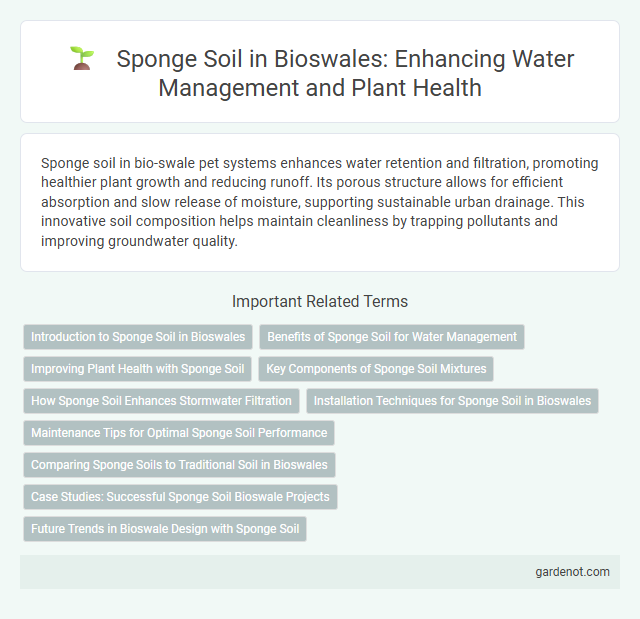Sponge soil in bio-swale pet systems enhances water retention and filtration, promoting healthier plant growth and reducing runoff. Its porous structure allows for efficient absorption and slow release of moisture, supporting sustainable urban drainage. This innovative soil composition helps maintain cleanliness by trapping pollutants and improving groundwater quality.
Introduction to Sponge Soil in Bioswales
Sponge soil in bioswales refers to a specially engineered soil mixture designed to maximize water infiltration and retention. This soil type typically combines sandy, loamy, and organic materials to enhance permeability and support microbial activity, promoting efficient pollutant filtration. Its unique porous structure mimics a natural sponge, reducing runoff and improving groundwater recharge in urban stormwater management systems.
Benefits of Sponge Soil for Water Management
Sponge soil enhances water management by improving soil infiltration and retention capacity, reducing surface runoff and flooding risks in urban and agricultural landscapes. Its porous structure facilitates groundwater recharge and supports healthier plant growth by maintaining optimal moisture levels. The use of sponge soil also aids in filtering pollutants, promoting cleaner water cycles and sustainable ecosystem health.
Improving Plant Health with Sponge Soil
Sponge soil enhances plant health by improving water retention and oxygen availability in the root zone, reducing drought stress and promoting robust root development. Its porous structure facilitates efficient nutrient absorption and microbial activity, crucial for plant growth and resilience. Integrating sponge soil in bio-swales supports sustainable irrigation and boosts plant vitality in urban landscaping.
Key Components of Sponge Soil Mixtures
Sponge soil mixtures consist of biochar, compost, and sand, engineered to maximize water retention and nutrient availability for bio-swales. These key components work synergistically to enhance soil permeability, promote microbial activity, and filter pollutants effectively. Integrating organic matter and coarse textures supports both stormwater management and soil health in urban green infrastructure.
How Sponge Soil Enhances Stormwater Filtration
Sponge soil, characterized by its high porosity and organic content, significantly enhances stormwater filtration by increasing water infiltration rates and trapping pollutants. Its structure allows stormwater to percolate slowly through microbial-rich layers, effectively breaking down contaminants and reducing runoff volume. This process improves groundwater recharge while mitigating urban flooding and water pollution.
Installation Techniques for Sponge Soil in Bioswales
Sponge soil installation in bioswales involves layering amended soil materials with high organic content and enhanced porosity to maximize water absorption and filtration. Precise grading and compaction control are critical to ensure optimal infiltration rates and prevent clogging, while incorporating native plant roots further stabilizes the soil structure and enhances pollutant breakdown. Using geotextile fabrics beneath the sponge soil layer can improve drainage efficiency and maintain soil integrity over time.
Maintenance Tips for Optimal Sponge Soil Performance
Regularly inspect sponge soil for compaction and aerate as needed to maintain optimal water infiltration and retention. Remove accumulated debris and sediment that can clog the soil, ensuring unobstructed flow and pollutant filtration. Periodic replacement or rejuvenation of the sponge soil layer supports long-term effectiveness in stormwater management and urban runoff control.
Comparing Sponge Soils to Traditional Soil in Bioswales
Sponge soils in bioswales exhibit significantly higher water retention capacity compared to traditional soils, enhancing stormwater infiltration and reducing runoff. The increased porosity and organic matter content in sponge soils promote microbial activity, improving nutrient cycling and pollutant filtration. These properties make sponge soils more effective in managing urban stormwater and supporting sustainable water management practices.
Case Studies: Successful Sponge Soil Bioswale Projects
Sponge soil bioswales have demonstrated exceptional stormwater management in urban landscapes, as evidenced by the Chicago Green Alley Project, which reduced runoff volume by 83%. The Portland Eco-District initiative utilized sponge soil bioswales to improve water infiltration, resulting in a 45% decrease in localized flooding and enhanced groundwater recharge. In Singapore's Bishan-Ang Mo Kio Park, sponge soil bioswales contributed to flood mitigation while supporting urban biodiversity, showcasing sustainable urban drainage effectiveness in tropical environments.
Future Trends in Bioswale Design with Sponge Soil
Sponge soil technology in bioswale design enhances water retention and filtration by mimicking natural soil sponge properties, promoting effective stormwater management and groundwater recharge. Future trends emphasize integrating advanced permeable materials and microbial enhancements to improve pollutant breakdown and soil aeration. Innovations in sponge soil formulations aim to boost resilience against urban flooding and support sustainable green infrastructure development.
Sponge soil Infographic

 gardenot.com
gardenot.com